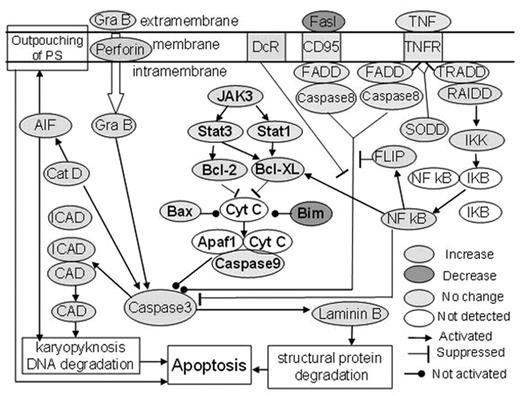Abstract
We recently demonstrated PNAS-2 serving as both an anti-apoptotic gene and an oncogene which is specifically up-regulated in acute leukemic patients (Hai-Rong WANG, et al. Oncology, Accepted). However, its role in apoptotic pathway remains elusive. Antibody microarray was applied to study the apoptosis-associated proteins’ changes to elucidate its role in apoptotic pathway. After PNAS-2 was inhibited by RNA interference, caspase3 was up-regulated confirming that PNAS-2 had an anti-apoptotic function. The activation of extrinsic, receptor-mediated apoptotic pathway was characterized by binding a death ligand to the corresponding death receptor. In this study, there were no changes in TNFα, CD95/Fas, TNFR, FADD, TRADD and caspase8 though Fas ligand decreased, while the apoptotic inhibitors such as DcR1 and FLIP were up-regulated, indicating there was no activation in the extrinsic apoptotic pathway. As to the apoptogenic proteins of classical intrinsic apoptotic pathway, there were no changes in Bax and caspase 9 though Bim was down-regulated, while the apoptotic inhibitors such as Bcl-2, Bcl-XL were up-regulated, indicating there was no activation in the intrinsic apoptotic pathway as well. Apart from the two classical apoptotic pathways (intrinsic and extrinsic), Granzyme B (GraB)-perforin apoptotic pathway is one well defined extrinsic accessory way of triggering apoptosis. In our data, GraB and Perforin were up-regulated, suggesting the GraB-Perforin apoptotic pathway was also activated. The apoptosis-induced factor (AIF) and Cathepsin D (CatD) were also up-regulated. AIF could induce apoptosis via a caspase-independent pathway, and Cat D could selectively escape AIF from mitochondria when translocated into the cytosol from lysosome, while other apoptogenic proteins resided in the intermembrane space of mitochondria such as cytochrome c and endonuclease G remained in the mitochondria (Nicolas Bidere, et al. JBC, 2003). Our data indicated that the AIF-induced-caspase-independent pathway was activated when PNAS-2 was inhibited. The changes in protein levels of CatD, AIF and GraB were confirmed by Western Blot. Mannose-6-Phosphate receptor (M6Pr) is the target receptor for GraB and CatD, mediating uptake of the proteases to form vesicles via endocytosis. This receptor also serves to transport newly synthesized GraB and CatD into the vesicles. The vesicles would form a structure named multivesicular body (MVB), which served to sort vesicles’ content destined for degradation or routing to the lysosome. CHMP5 (the alias of PNAS-2) located in MVB and lysosome, and the loss of CHMP5/PNAS-2 could inhibit lysosomal degradation (Jae-Hyuck Shim, et al. JCB, 2006). As GraB and CatD could trigger apoptosis when they were effluxed from the lysosome, we hypothesize that the overexpression of PNAS-2 in leukemic patients might execute its anti-apoptotic function by increasing the lysosomal degradation of apoptogenic factors in lysosome such as CatD and GraB.
Author notes
Disclosure:Research Funding: 1, Research Fund from Chinese National Natural Science Foundation. (NO. 30670881). 2, Research Fund from Shanghai Municipal Education Commission. (NO. 05BZ37). Off Label Use: 1, Research Fund from Chinese National Natural Science Foundation. (NO. 30670881) 2, Research Fund from Shanghai Municipal Education Commission. (NO. 05BZ37).


